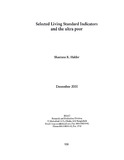| dc.contributor.author | Halder, Shantana R. | |
| dc.date.accessioned | 2019-09-11T06:58:54Z | |
| dc.date.available | 2019-09-11T06:58:54Z | |
| dc.date.issued | 2000-12 | |
| dc.identifier.citation | Halder, S. R. (2000). Selected living standard Indicators and the ultra poor. Research Reports (2000), Economic Studies, (XVI), 109–134. | en_US |
| dc.identifier.uri | http://hdl.handle.net/10361/12546 | |
| dc.description.abstract | This report aimed to give a clear picture on the nature of their vulnerability and
potentiality to cope wit by analysis their non-land asset base, ownership of savings and
their level of human poverty. It was estimated that 91% of the ultra poor possessed any
kind of non-land assets, 62% owned any productive assets and only 19% had savings.
Average value of total non-land assets was only Tk. 3,787 at current price, of them
value of productive assets constituted only 26%. Results on human poverty showed
that 96% of the ultra poor used tube-well water for drinking, 88% for cooking, 76% for
dish washing, 39% for cloth washing and 38% for bathing. Only 14% used slab/pit
latrine for defecation. Eighty percent of the adult males and females possessed
minimum two pieces of ordinary cloths. Access to winter clothing and footwear for all
household members were for only 12% and 30% households respectively. | en_US |
| dc.language.iso | en | en_US |
| dc.publisher | Research and Evaluation Division, Brac | en_US |
| dc.subject | Ultra poor | en_US |
| dc.subject | Living standard | en_US |
| dc.subject | NGOs | en_US |
| dc.subject.lcsh | Household surveys -- Bangladesh. | |
| dc.subject.lcsh | Poverty--Bangladesh. | |
| dc.title | Selected living standard indicators and the ultra poor | en_US |
| dc.type | Research report | en_US |

